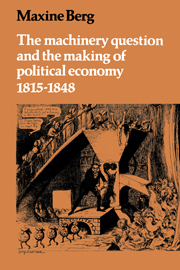Book contents
- Frontmatter
- Contents
- List of Illustrations
- Preface
- Introduction
- PART ONE THE MACHINERY QUESTION
- PART TWO THE POLITICAL ECONOMY OF MACHINERY
- PART THREE A SCIENCE OF MACHINERY
- PART FOUR THE POLITICS OF MACHINERY
- PART FIVE THE SOCIAL CRITICS OF MACHINERY
- 11 Tories
- 12 Radicals
- 13 Social reformers
- EPILOGUE: BEYOND MACHINERY
- Bibliography
- Index
- Frontmatter
- Contents
- List of Illustrations
- Preface
- Introduction
- PART ONE THE MACHINERY QUESTION
- PART TWO THE POLITICAL ECONOMY OF MACHINERY
- PART THREE A SCIENCE OF MACHINERY
- PART FOUR THE POLITICS OF MACHINERY
- PART FIVE THE SOCIAL CRITICS OF MACHINERY
- 11 Tories
- 12 Radicals
- 13 Social reformers
- EPILOGUE: BEYOND MACHINERY
- Bibliography
- Index
Summary
The handloom weavers’ debates exposed a widespread reaction against machinery in society. This reaction was many sided. A staunchly Tory outlook spurned industrial society altogether. Radicals and workers, on the other hand, attributed poverty and unemployment to the machine in the hands of capitalist employers, but hoped to harness its benefits to themselves in a co-operative society. Finally, middle-class social reformers were stirred to investigate the recesses of poverty, and discovered the social effects of mechanisation. In the following three chapters I will analyse these three types of opposition to machinery, to be found in the upper classes, the radical working classes, and the reforming middle classes.
I will indicate the extent to which resistance to machinery was related to an opposition towards political economy in sill three groups. The revulsion among Tories and radicals against the contemporary road to industrialisation was simultaneously a revulsion against the political economy which justified it. The response of the social reformers was to defend political economy by creating a separate field of inquiry for the social effects of industrialisation. In dealing with the ‘Tory’ outlook I will argue that, though individual responses among the Tories varied, the resistance to machinery was the unifying principle of their social and economic perspectives. This chapter will first survey the ‘reviews’ and other literature which expressed Tory opinion. It will then outline the various political sects within Toryism with their distinguishing characteristics: liberal Tories, country Tories, Young Englanders and Tory radicals.
- Type
- Chapter
- Information
- Publisher: Cambridge University PressPrint publication year: 1980

